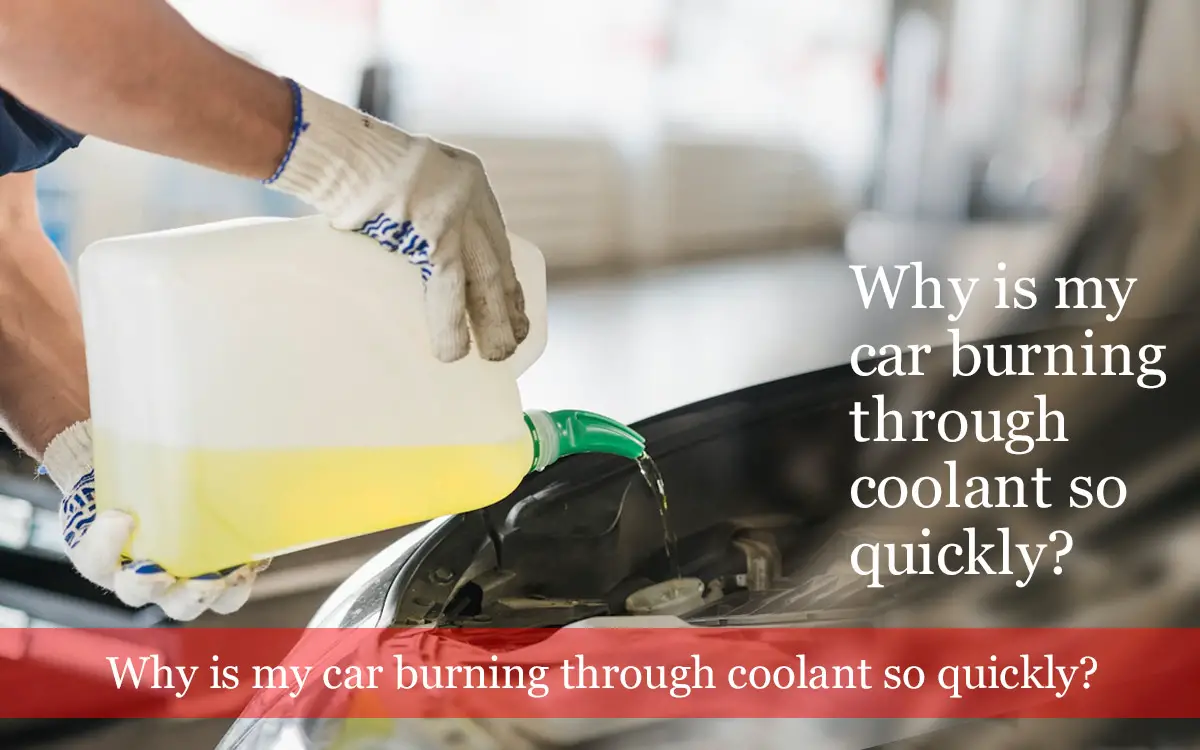Have you ever found yourself scratching your head, wondering why on earth your car seems to have an insatiable thirst for coolant? You fill it up one day, only to find that it’s mysteriously low again the next. It’s a frustrating and perplexing problem that many car owners face: rapid coolant loss.
So sit back, buckle up, and prepare to diagnose the causes of this mysterious coolant loss in your beloved vehicle. Whether you’re a seasoned car enthusiast or just starting to delve into the world of automotive mysteries, this article will uncover the secrets that lie beneath the surface. Let’s get down to the business of solving this coolant conundrum!
Reasons why your Car is burning through Coolant
There are a couple of reasons why your car might be burning through coolant faster than you might like.
- Leakage
- Overheating
- Pressure Cap/Fan Clutch Malfunction
- Coolant System Contamination
- Faulty Thermostat
1. Leakage
I would say the most common cause of your coolant loss is leakage. This can be caused by a number of things, such as a cracked radiator hose, worn-out seals or gaskets, loose connections in the cooling system, or a faulty water pump. If you suspect any of these, then the best course of action is to take your vehicle to a qualified mechanic for diagnosis and repairs.
I remember a customer who came to my workshop worried something was leaking from her car. After some investigation, it turned out to be coolant coming from a faulty thermostat housing gasket. It was an easy fix and the customer left satisfied with their newly sealed car.
2. Overheating
Another cause for your vehicle drinking up all its coolant can be overheating. If your engine is running at too-high temperatures, this can cause the coolant to evaporate, leading to rapid loss of coolant in your car. This is usually caused by a malfunctioning cooling fan or worn-out radiator parts such as the fan clutch, pressure cap, or thermostat.
To determine whether this is the cause of your problem, you can use an infrared thermometer to check the temperature of different parts of the cooling system.
If you do find that your car is overheating, then it’s important to get the faulty part replaced as soon as possible before permanent damage is done to your engine.
You can also keep an eye on your vehicle’s temperature reading while driving. If it starts to creep up after a few minutes, take your car in for an inspection.
3. Pressure Cap/Fan Clutch Malfunction
In some cases, a malfunctioning pressure cap can cause your coolant to boil over and escape from the system. This is usually caused by a faulty fan clutch or radiator cap that is no longer capable of sealing properly. If you are able to locate the leak, this is a good indication that one of these components needs to be replaced.
It’s important to remember that even with minor coolant loss, your engine temperature can still get too high and cause damage over time. It’s best to take your vehicle in for an inspection as soon as possible if you experience any rapid coolant loss.
4. Coolant System Contamination
Coolant system contamination can also be a cause for your rapid coolant loss. This happens when foreign particles or contaminants get into the coolant, causing it to break down and leak out of the system at an accelerated rate. The most common causes of such contamination are old, dirty coolant, poor quality coolant, or improper servicing procedures.
If you suspect contamination might be causing your rapid coolant loss, have your mechanic flush and fill the system with new coolant as soon as possible. There was a time when car owners had to add coolant every few months, but with the improved quality of modern coolants, it’s unlikely that contamination would be a problem.
However, if you have an older car or are unsure of its maintenance history, it’s always a good idea to have your mechanic check for signs of contamination.
5. Faulty Thermostat
Finally, a faulty thermostat can also cause rapid coolant loss. This happens when the thermostat fails to control the temperature of the engine and allows the coolant to escape at a constant rate. In this case, the only solution is to replace the thermostat with a new one.
In case you don’t know what a thermostat is, It is a device that is used to regulate the temperature of an engine. It consists of a wax cylinder filled with heat-sensitive liquid, which expands when heated. This expansion causes the thermostat to open or close in order to regulate the flow of coolant into the engine.
Faulty thermostats can be difficult to diagnose because they often won’t show any signs of wear or tear. However, a professional mechanic can test your thermostat to make sure it’s functioning correctly.
Now that you know why your car is burning through coolant, let’s take a look at how you can prevent it from happening in the future.
How to Make Sure Your Coolant is in Good Condition
These are the steps to make sure your coolant is in good condition.
- Flushing
- Replacement
- Additives
1. Flushing
Flushing is an important part of coolant maintenance. This process removes contaminants and solids from the system, allowing the coolant to flow more freely and without interruption. I would suggest you have your mechanic do this for you, as they will know how to properly drain and flush the system without damaging anything.
It is a delicate process, and if done incorrectly, can cause more damage than good.
2. Replacement
Again, replacement is also an important step in coolant maintenance. Depending on how old your car is, it may be time to replace the coolant with a new one. There are different types of coolants available that offer different levels of protection against corrosion and overheating. You should check with your mechanic for the best advice on which type of coolant is right for your car.
3. Additives
Finally, adding coolant additives like anti-corrosion or seal conditioners can be beneficial. These additives help to improve the performance of your engine and extend its life span. This is especially true if you are driving in extreme temperatures or driving in dusty conditions. Coolant additives help to lubricate the system and reduce corrosion caused by the elements. In addition, it can help to seal any minor cracks or leaks in the cooling system that may be causing coolant loss.
It’s important to check your vehicle’s specific manual for instructions on how often you should replace and/or add coolant additives as part of regular maintenance.
By following this advice and taking the time to understand what is causing your car’s rapid coolant loss, you can keep your car running smoothly and efficiently for many years to come.
These are the basics of rapid coolant loss and how to maintain your car’s cooling system.
Conclusion
Now you know why your coolant is important and what steps you can take to minimize rapid coolant loss. To keep your car running smoothly and efficiently, it’s important to stay up-to-date with regular maintenance. From time to time, check the levels of your vehicle’s coolant and make sure you’re using the right kind for your engine.
No matter the cause of your rapid coolant loss, it’s important to address the issue as soon as possible. If you delay in addressing the problem, you risk further damage to your engine or other parts that could lead to costly repairs. By following this guide and paying attention to your car’s maintenance needs, you will be able to keep it running smoothly for many years to come.
If you find yourself in need of additional assistance or advice with regard to rapid coolant loss, feel free to speak with a professional mechanic about the issue. They can help you diagnose any underlying issues that may be causing the problem and find a solution that is best for your car.
Tips
- Remember to always wear protective gloves and eye protection when working with coolant or other vehicle fluids!
- Regularly check your vehicle hose connections to make sure they are securely fastened in place. This will help reduce any potential coolant loss.
- Be sure to keep a spare bottle of coolant in your car in case of emergency. This will make it easier to top off any lost fluids quickly and efficiently.

